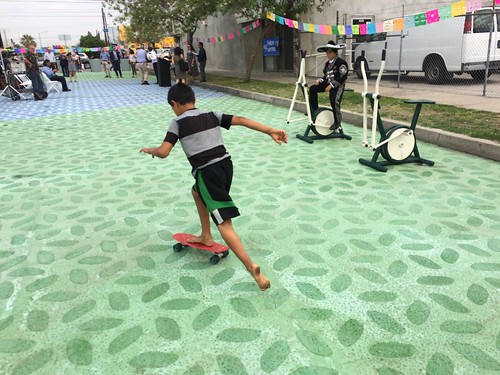On a sunny August afternoon in Boyle Heights, Mayor Garcetti signed his tenth executive directive since taking office and launched the City’s new Vision Zero initiative, or #VisionZeroLA! The Mayor was joined by local traffic safety proponents, including our very own General Manager Seleta Reynolds, LAPD Chief Charlie Beck, Councilmembers Mike Bonin and Mitchell Englander, other members of the City family, and a newly formed coalition of organizations in support of safer streets for everyone called Los Angeles Vision Zero Alliance (LA0).
#VisionZeroLA represents a commitment on behalf of the City of Los Angeles to eliminate traffic-related fatalities by 2025. According to the Mayor’s Office, the City’s Vision Zero policy “is based on the fundamental principle that traffic deaths can be avoided through strategic, data-driven approaches to engineering, enforcement, education evaluation, and community engagement.”

Mayor Garcetti adjusts the mic before announcing #VisionZeroLA.
In a typical year, roughly 200 people are severely injured or killed in traffic collisions in Los Angeles. Approximately 44% of these collisions involved a person walking or riding a bicycle. Vision Zero LA aims to focus multiple City departments to collaborate and develop measures that will reduce the number of traffic-related fatalities and severe injuries from 200 to zero. To this end, our GM Seleta Reynolds will lead the Department to ensure our transportation system offers people safe and comfortable mobility. “We must transform our city so that our youth and older adults aren’t risking their lives just to get around town,” said Seleta.
Tackling traffic safety in a city with over 4,500 miles of streets is an ambitious task. According to the Vision Zero LA team, however, of the 30,000 collisions a year in Los Angeles, about 65% of those that result in a pedestrian death or severe injury take place on only 6% of the City’s streets. This proportion of street segments is known as the High-Injury Network and will be the focus of the City’s initial efforts and safety improvements.
Increase Safety, Decrease Costs
Any death or injury resulting from a traffic collision on our streets is one too many. Traffic collisions have a detrimental impact on the city and its residents: physical and emotional pain of the victims and their families, significant economic costs and financial burdens, adverse effects on health and safety, inefficiencies in the transportation system, and lower quality of life for all. Not only will #VisionZeroLA create invaluable benefits for our communities like reducing the physical and emotional harm these type of tragedies cause and ensuring all residents feel safe using our streets, this initiative will also save Los Angeles residents from the financial burden on society generated by traffic collisions that we do not immediately recognize.
A recent report from the National Highway Traffic Safety Administration (NHTSA) reveals that all traffic collisions cost the U.S. economy about $836 billion in 2010—$594 billion in value of social harm and $242 billion in economic costs. This staggering figure accounts for 32,999 fatalities, 3.9 million non-fatal injuries, and 24 million damaged vehicles. NHTSA researchers estimate the economic cost of crashes based on factors such as property damage, lost earnings, lost household production, medical expenses, emergency services, travel delay, workplace costs, and legal fees, while the societal impacts of collisions are quantified based on physical and emotional pain and loss of quality of life.
The economic cost of each traffic-related fatality to society is approximated at nearly $1.4 million; more than 95% of this amount accounts for lost time in the workplace and household, absent contributions to the market, and legal expenses. A cost breakdown from the NHTSA report based on severity of traffic collision is included below:

In 2010, Californians paid 8.3%, or $19 billion, of the total economic cost of traffic collisions nationwide, the greatest proportion out of any other State.
Based on the 200 traffic-related fatalities and severe injuries in Los Angeles in 2013 and cost estimates from the NHTSA, the LADOT Bike Blog estimates these fatalities cost our City nearly $280 million. The varying costs of collisions are summarized in the table below, differentiated by the extent of injuries and types of transportation modes involved. Over half of the reported 200 fatalities were people walking or riding their bicycle. Cost details for collisions without reported injuries (i.e. vehicle damage alone) were not included.

The 28,896 traffic-related injuries and fatalities that occurred citywide in 2013 cost all of us approximately $3.681 billion, or $367.36 per resident. In other words, it makes fiscal sense for the city to provide safer infrastructure in order to reduce fatalities and injuries, and avoid a portion of these costs in addition to the other damages caused by traffic collisions.
There is no replacing the loss of a life and to get an idea of the financial toll serious traffic collisions have on our city, here are a few things $3.681 billion could pay for:
- Construction of 4.5 out of 9 miles of Metro’s Purple Line expansion.
- Rebuilding the LAPL Silver Lake Branch 334 times.
- Development of about 65 public parks similar to Grand Park or Wilmington Waterfront Park.
- Repairs to more than 18,000 miles of the city’s sidewalks.
- Installation of approximately 3,681 miles of protected bicycle lanes throughout the city (based on the Department’s cost estimate of $1 million a mile)
- Buildout of the entire Los Angeles River Bike Path within City limits (based on cost estimates in the Los Angeles River Revitalization Master Plan)
For more information on #VisionZeroLA visit visionzero.lacity.org and follow @VisionZeroLA.






